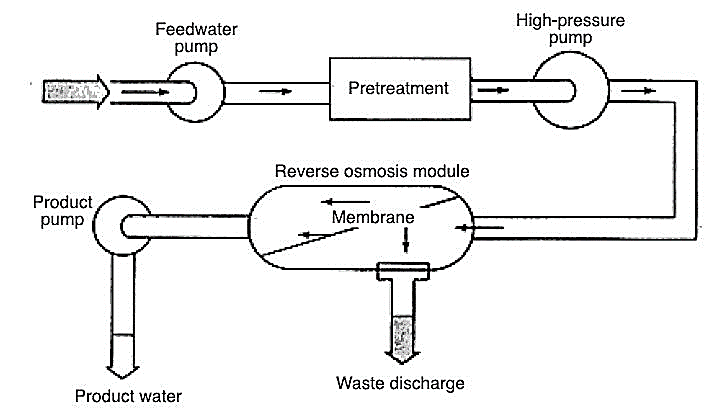
Seawater Desalination with Reverse Osmosis Plant
All Reverse Osmosis crops are fundamentally Desalination Crops but desalination is becoming referred to sea drinking water Ordinarily.As sea water has really superior TDS demands quite superior pressure to force sea water by way of membranes which are distinct then brackish drinking water membranes.
Reverse Osmosis Plant Information:
A reverse osmosis plant is usually a producing plant, where h2o is purified and desalinated by forcing h2o via a membrane, typically referred to as a reverse osmosis method. Water produced by plant RO may be used for several functions like desalination, wastewater therapy, and also the reclamation of dissolved minerals.
RO Plant Description
An average ingesting h2o RO plant technique calls for six KW hours of energy to desalinate a person cubic meter of h2o. Reverse osmosis drinking water plants requires several different pre-cure approaches like softening, DE chlorination, and anti-scale remedy. Following pre-procedure, substantial levels of tension ship water by way of a semi-permeable membrane, which holds all contaminants other than water.
RO Plant Structure
To boost the performance and life of the Reverse Osmosis plant, effective pretreatment with the feed water is needed. Choice of the appropriate pretreatment will increase effectiveness and membrane lifestyle by cutting down:
Fouling
Scaling
Membrane Degradation
RO plant design and style is consisting of:
Pinpointing pretreatment necessity of Reverse Osmosis Plant
Should the feed water has traces of weighty metals, it is very advised to dose some chlorine to alter the dissolved major metals to physical kind, the media filter will filter most of it within a ro drinking water purifier plant.
Reverse Osmosis Plant Array of membrane
Membrane components are a significant part of RO plants. The proteins (largely polyamide) that makeup membrane aspects differ based on the ending clarity and consumption drinking water seawater or brackish drinking water and so forth
Waterman engineers Australia RO plant for seawater desalination
Waterman Engineers in Australia has intended a Reverse Osmosis (RO) plant for seawater desalination, which features several benefits above other desalination approaches. Here are several critical advantages of their RO plant:
Electricity Effectiveness:
As compared to other desalination procedures like thermal distillation, RO necessitates fewer Electrical power. Waterman Engineers' RO plant makes use of Innovative membrane know-how, letting it to function at reduced pressures and decrease overall Electrical power intake.
Environmental Effect:
RO generates much less brine discharge in comparison to thermal solutions, cutting down the effect on maritime ecosystems. This aligns with Australia's target environmental sustainability and conservation.
Higher H2o Purity:
The RO approach successfully gets rid of salts, minerals, and impurities, generating high-good quality freshwater that meets stringent consuming h2o specifications. This trustworthiness is vital for providing Risk-free and clean drinking water to communities.
Modular Structure:
Waterman Engineers' RO plant employs a modular design and style, allowing for for scalability and flexibility. This is particularly beneficial for areas with varying drinking water calls for, as modules can be additional or modified appropriately.
Reduced Footprint:
RO plants normally Have got a smaller physical footprint when compared with thermal desalination crops, which frequently require substantial infrastructure for heating and cooling processes.
Swift Start out-Up and Shutdown:
RO crops is usually started and stopped comparatively speedily, letting for superior responsiveness to switching h2o requires and emergencies.
Lessen Chemical Use:
Compared with A few other desalination solutions, RO necessitates much less chemical compounds for operation and cleaning, reducing chemical-linked environmental problems.
Consistency in Efficiency:
The RO method is significantly less sensitive to feedwater high-quality fluctuations than other procedures, guaranteeing a more dependable general performance after some time.
Value-Usefulness:
While First expenditure expenses is usually important, RO plants are inclined to get lessen operational and servicing costs In the long term in comparison with thermal methods.
Reverse Osmosis (RO) can be a water purification approach that uses a partially permeable membrane to get rid of ions, unwanted molecules, and larger particles from consuming h2o. By applying strain to beat osmotic pressure, it makes it possible for the passage of h2o molecules whilst rejecting contaminants, therefore manufacturing clean water on just one facet from the membrane and concentrated impurities on another.
The Performing basic principle of the Reverse Osmosis (RO) plant entails making use of strain to your saline solution to force water molecules through a semi-permeable membrane. This membrane permits only drinking water to move even though rejecting salts, contaminants, and impurities, leading to Desalination Plant Manufacturer purified drinking water to the permeate facet in addition to a concentrated solution of contaminants on the brine side.
The advantages of Reverse Osmosis include creating higher-top quality, thoroughly clean water by removing contaminants, being efficient and price-productive after some time, necessitating nominal chemical use, and getting adaptable to various scales of Procedure from modest residence techniques to big municipal crops.
RO vegetation have replaced Demineralisation (DM) crops given that they usually provide a additional productive and cost-productive Resolution for water purification. RO devices Never require the regeneration chemical compounds that resin-primarily based DM crops do and may take out a broader variety of contaminants, such as dissolved solids and microorganisms.
Waterman Engineers Australia probable makes use of Reverse Osmosis (RO) crops for seawater desalination by forcing seawater through a semi-permeable membrane to get rid of salt and other impurities. This process provides refreshing, potable h2o from the ocean, addressing drinking water scarcity and furnishing a sustainable supply for a variety of needs.